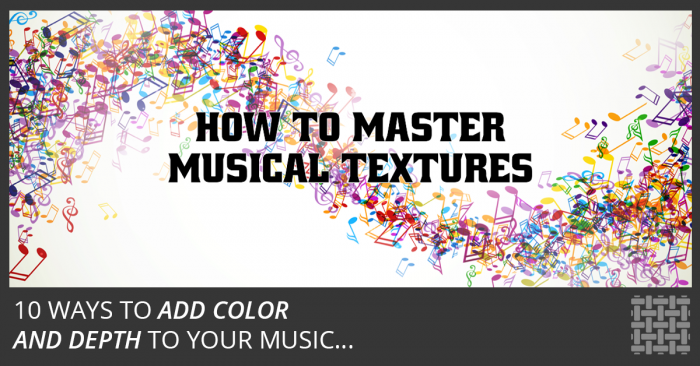
If you need more compositional choices or your music needs more depth, you might want to play with the textural qualities of music. This won’t be difficult because I’ve prepared a textural dictionary for you.
- Polyphonic, while literally meaning “many-voiced,” refers to multivoiced texture of considerable interlinear independence, often imitative; it is understood to have qualitative implications beyond its literal, limited meaning.
- Homophonic would literally denote a condition of interdependent voices, but its traditional connotation is of texture where a primary voice is accompanied by a subordinate fabric sometimes interactive in tentative ways, the bass normally in a contradirectional or other contrapuntal relation to the primary voice (or voices).
- Chordal is a term referring to texture consisting essentially of chords, its voices often relatively *homorhythmically related.
- Doubling refers to lines *homorhythmically-homodirectionally-homointervallically associated.
- Mirror association, usually understood as strict, involves a relation that is homorhythmic-homointervallic-contradirectional.
- Heterophonic is a relation that is *homodirectional (parallel in contour) but *heterointervallic-having minor diversification of interval content.
- Heterorhythmic is a term that means having dissimilar rhythms (see below).
- Sonority is defined as the overall resonant character determined by texture (including doublings) and coloration (including articulation and intensity of dynamics.)
- Counterpoint (contrapuntal) is a condition of interlinear interaction involving intervallic content, direction, rhythm, and other qualities or parameters of diversification.
- Monophonic means single-voiced (monolinear).
From Theory of Harmony by Arnold Schoenberg:
*In the following system, the prefixes homo- (uni-, or co-), hetero-, and contra- are adopted to refer to conditions of identity, mild and very local diversification (as in the conventional “hetereophonic”), and more pronounced contrast, respectively. Moreover, three specific parameters (aspects, dimensions, spheres of reference) are adopted as relevant to the evaluation of textural conditions: these are rhythm (specifically rhythmic pattern), direction (of melodic succession), and linear intervallic content.
- Within the parameter of rhythm, the terms homorhythmic, heterorhythmic, (both of these in conventional usage), and contrarhythmic all emerge as potentially applicable and useful.
- Within the parameter of direction, the terms homodirectional, heterdirectional, and contradirectional (“motion” in a straight line exists as a possibility along with motion up and down) all have potential applicability to relations among components of texture.
- Within the sphere of intervallic content, the terms homointervallic, heterointervallic, and contraintervallic can all be used to describe particular textural situations and relations, usually applying to specific intervals rather than classes.
Understanding musical texture will give your music more creativity, originality, depth, as well as justification for your musical choices. Master these qualities and experience unlimited compositional options.
Click here: Arranging and Editing with Logic Pro X
